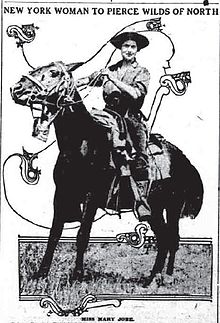Mary Jobe Akeley
| Mary Jobe Akeley | |
|---|---|

Mary L. Jobe, c 1913
|
|
| Born |
29 January 1878 Tappan, Ohio, United States of America |
| Died | 19 July 1966 (aged 88) Mystic, Connecticut, United States of America |
| Resting place | Patterson Union Cemetery, Deersville, Ohio. |
| Nationality | American |
| Occupation | naturalist, writer, explorer, cartographer |
| Spouse(s) | Carl Ethan Akeley |
Mary Jobe Akeley (29 January, 1878 – 19 July, 1966) was an American explorer and naturalist, famous as one of the earliest woman explorers in Africa where she and her husband hunted and photographed animals during their natural history studies. She is the author of Carl Akeley's Africa, published in 1929, Lions, Gorillas and Their Neighbors, published in 1932 and Congo Eden published in 1950. Mount Jobe in Canada was renamed in her honor to acknowledge her exploration efforts in the Rocky Mountains.
Mary Lenore Jobe Akeley was born to Richard Watson and Sarah Jane Pittis Jobe on 29 January 1878. She grew up on her parents' farm in Tappan, Ohio and graduated from Scio College, Ohio. After graduation she taught at a public school until 1901 when she joined Bryn Mawr College. She later transferred to Columbia University, New York where she received her Master of Arts degree in 1909 after which she joined Hunter College as faculty in History.
She began exploring areas of British Columbia in 1905. In 1907 she traveled for three months in a small party led by Dr. Charles J. Shaw, exploring the Selkirk Mountains. A later expedition, led by Professor Herschel Parker, was the first to set foot on Mount Sanford. By September 1913, she had made six trips exploring British Columbia and studying the Carrier Indians in their villages. In 1913, in an expedition lasting ten weeks and covering over 800 miles, she travelled alone except for an occasional Indian guide hired to take her to the next village. For many of the Indians, she was the first white woman they had ever seen. They promptly dubbed her Dəne tsʼeku, their native language for "Man-Woman," because of her clothing and straightforward demeanor.
In 1913, while at Hunter College, the Canadian Government commissioned her to study the customs and history of Eskimos and Indian tribes in the Canadian Northwest. While studying and photographing the native tribes in the region, she explored regions of the Canadian Rockies and mapped the Fraser River in 1914, and in 1915 discovered and mapped the then unnamed and unexplored Mount Sir Alexander locally known as Big Ice Mountain, making two unsuccessful attempts to ascend the peak. She was nominated as a fellow of The Royal Geographic Society of London and was awarded a membership in the American Geographical Society for her work in this period. She was also an early member of the American Alpine Club. Mount Jobe was renamed in her honor by the Geographic Board of Canada in 1925.
...
Wikipedia
